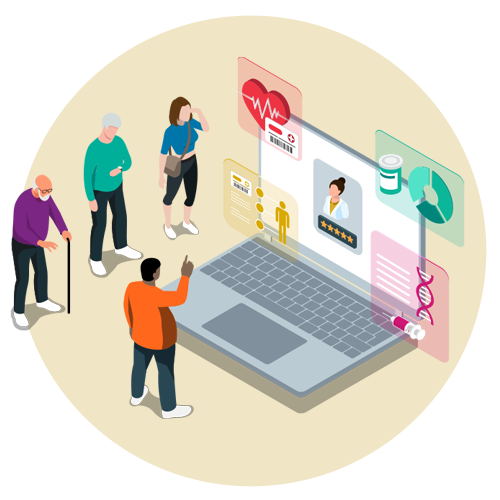
Phreesia Life Sciences surveyed nearly 2,000 patients as they were checking in for their doctors’ appointments to better understand their perceptions and preferences around telehealth. View the key data insights in this infographic.
Telehealth use skyrocketed early in the COVID-19 pandemic, accounting for nearly 25% of all doctors’ appointments at its peak. And while virtual visits have since dropped off, it remains a popular care medium, supporting millions of appointments each year.
In 2022, more than one-third of patients (36%) who checked in for a doctor’s appointment on the Phreesia platform reported having had a virtual healthcare visit in the past 6 months, and that percentage held steady across age groups.
But will the trend continue in the coming years? Data from a Phreesia survey completed by nearly 2,000 patients suggests that it will.
Telehealth is still widely used across age groups…
- 34%—Ages 18 to 44
- 36%—Ages 44 to 65
- 36%—Ages 65+
…and general satisfaction remains high.
- 72% of recent telehealth users feel very or extremely comfortable asking for a new prescription during a virtual visit
- 75% of recent telehealth users feel very or extremely comfortable bringing up a new health issue during a virtual visit
Telehealth users rate their doctor as very good or excellent at:
- 61%—Answering their questions
- 59%—Addressing their health concerns
- 58%—Providing a treatment plan that fits their needs
In fact, most recent users say they’re likely to use telehealth in the future…
- 84% remain somewhat, very or extremely likely to use virtual healthcare visits in the next 12 months
…citing flexibility as their top reasons for continued use.
Reasons why recent users in 2022 were somewhat, very, or extremely likely to continue using virtual doctors’ visits in the next 12 months:
- 61%—They offer more flexibility with my schedule
- 60%—They save me time since I don’t have to travel or wait for my in-person appointment
- 37%—It is quicker to schedule a virtual visit
- 33%—I feel comfortable discussing my health issues with my doctor virtually
- 18%—I don’t feel rushed during virtual visits
- 14%—It is a cheaper option
- 9%—Other
Telehealth users who plan to continue using virtual visits say they’re most likely to see their primary care provider or a behavioral health professional virtually…
Types of doctors that recent users were planning to see using virtual visits in the next 12 months:
- 57%—Family doctor/primary care
- 23%—Behavioral health professional
- 10%—Ob/Gyn
- 6%—Neurologist
- 6%—Urologist
- 5%—Gastroenterologist
- 5%—Endocrinologist
- 5%—Orthopedist
- 5%—Pediatrician
- 4%—Dermatologist
- 4%—Cardiologist
…and rural patients are the most likely to continue using virtual visits in the next year.
Living area breakdown:
Very or extremely likely to continue using virtual doctor’s visits in the next 12 months
- 83%—Rural
- 61%—Suburban
- 62%—Urban
Telehealth appointments also offer great opportunities to supply patients with personalized resources.
Which of the following resources would you be interested in receiving before, during or after your telehealth appointment? Please check all that apply.
- 36%—Medication information materials relevant to me
- 26%—Patient support programs for my condition
- 22%—Doctor discussion guides
- 19%—Clinical trial offers relevant to me
- 17%—Disease education materials
- 13%—Tips on how to best use virtual visits
- 13%—Technical support for setting up virtual visits
- 10%—Access to patient communities
- 25%—Other
In summary…
Telehealth users like virtual care, and most are likely to continue using the medium in the next year because of its flexibility and efficiency. Rural patients in particular stand to benefit, with telehealth’s capacity to bridge access gaps and provide quality healthcare on a convenient platform.
No matter where they live, however, all patients stand to benefit from the continued prevalence and popularity of telehealth. Virtual appointments offer ongoing opportunities to receive personalized resources aligned with each patient’s treatment journey, including medication information, support programs and doctor discussion guides.
Find out how Phreesia Life Sciences’ digital engagement platform can help you reach more patients with education and support resources before, during and after their telehealth appointments.



